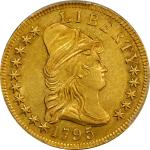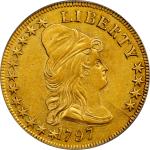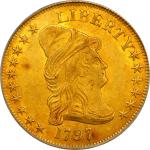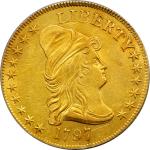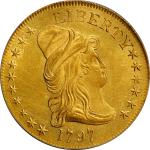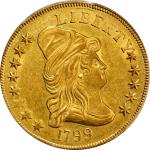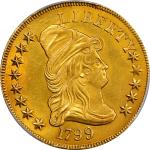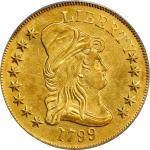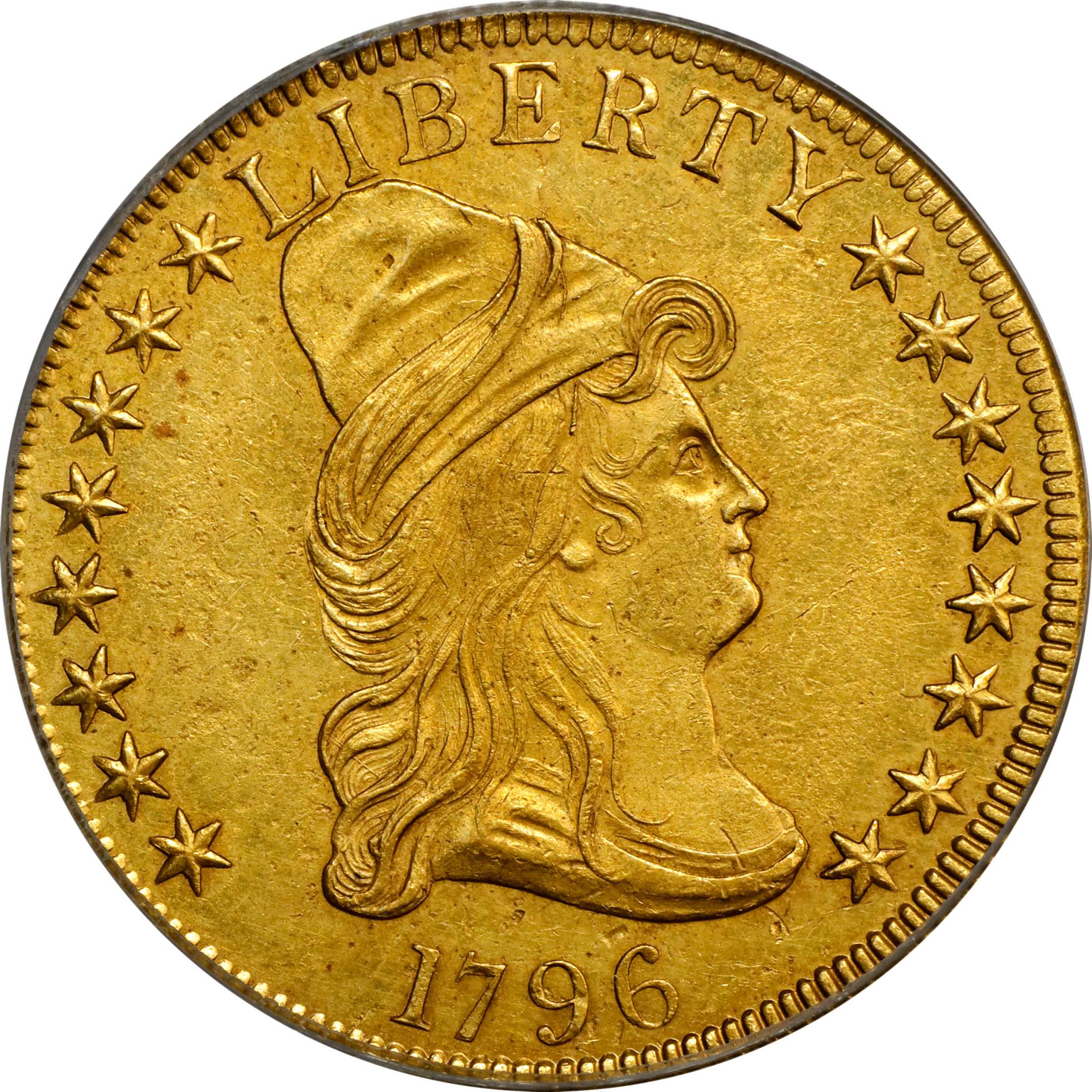1796 Capped Bust Right Eagle. BD-1, Taraszka-6, the only known dies. Rarity-4. MS-62 (PCGS). <strong>Type and Style:</strong> Type I: Capped Bust Right, Small Eagle. Style III: Head of 1795 with 16 stars arranged eight left, eight right; Reverse of 1796 with 11 leaves on the palm branch. The head and eagle punches are attributed to hubs prepared by Robert Scot. This issue represents the only use of Style III in the Capped Bust Right eagle series.<p><strong>Die Variety:</strong> BD-1, Taraszka-6, Breen 1-A, HBCC-3174. This is the only known die marriage for the 1796 Capped Bust Right eagle, the reverse also used to strike all known 1797 Small Eagle tens.<p><strong>Die State:</strong> BD Die State c/b. The obverse exhibits a light crack that begins in the field below the letter E in LIBERTY and continues through Libertys cap and the hair behind the ear before terminating at the edge of the bust above the digit 9 in the date. A second, considerably smaller crack is present from star 15 to the border. The reverse is lightly clashed, evidence for which is seen within the top of the wreath below the letters TES in STATES. This is the penultimate die state known for this variety.<p><strong>Estimated Mintage for the Issue:</strong> The mintage for calendar year 1796 is 4,146 coins, per Mint records. Dannreuther estimates that 3,500 to 4,146 eagles were struck from the only known 1796-dated die pairing. The authors lower estimate allows for the likelihood that many 1795-dated eagles were delivered during calendar year 1796. Additionally, the existence of a single 1796 eagle in BD Die State d/c confirms that some 1796-dated coins were also struck in 1797 (see below).<p><strong>Estimated Mintage for the Variety:</strong> Since there is only a single die variety known for the 1796 eagle, the estimated mintage for the variety is the same as that for the issue.<p><strong>Estimated Surviving Population for the Variety:</strong> Dannreuther provides an estimate of 125 to 175 coins extant in all grades.<p><strong>Strike:</strong> Exceptionally well struck, as sharp as any 1796 eagle we have seen, with more than usual detail at the extreme central obverse and especially bold detail on the eagle. When have we seen another 1796 eagle that showed the feathers on the eagles neck? Never perhaps, which makes this coin special indeed. The breast is nearly fully struck, again as nice as any specimen in existence.<p><strong>Surfaces:</strong> Even yellow-gold with halos of deeper reddish-gold toning around legends and devices. Somewhat reflective in the fields and retaining much of its original luster, though the fields on both sides show a substantial smattering of tiny natural planchet chips, as struck and not affecting the grade. Very few marks, hairlines, or post-striking flaws are noted - in large part a byproduct of the safe storage of this piece in Omaha from the time of Byron Reeds death in 1891, shortly after his active participation in the famous 1890 Lorin G. Parmelee sale.<p><strong>Commentary:</strong> This is a scarce early eagle, not as rare as the 1797 Small Eagle, but appreciably scarcer than the first year 1795. The 1796 is also highly significant to those who study and collect die varieties and die states of early eagles. It is the first eagle that displays 16 stars on the obverse. Clearly the only known obverse die of this issue was prepared after Tennessees admission to the Union as the 16th state on June 1, 1796. The reverse die is also significant due to its introduction of 11 leaves or fronds on the palm branch, likely the culmination of experimentation on the part of Mint personnel that began with the use of 13 leaves on most reverse dies of the 1795-dated issue and also saw the creation of the famous and scarce 1795 BD-3 9 Leaves variety. This reverse die would finish the Small Eagle series with its use in both the 1796- and 1797-dated issues. Finally, the 1796 as an issue is significant to variety specialists because it includes the first confirmed remarriage in the early eagle series. At least one 1796 eagle is known in BD Die State d/c, the reverse with a crack from the border through the right side of the letter O in OF to the wreath. Since this reverse also was used to strike all known 1797 Small Eagle tens, all confirmed examples of which do not display this crack, clearly some 1796-dated coins were struck after the 1797 Small Eagle pieces. The often-seen prominent obverse die crack on the 1797 Small Eagle coins likely resulted in the demise of that die and the brief return of the 1796-dated obverse to production (see below, in our description for the 1797 Small Eagle coin in this collection). This premium quality 1796 is ranked #2 in the list of "Significant Specimens" for the issue in Anthony J. Taraszkas book <em>United States Ten Dollar Gold Eagles: 1795-1804</em>. It hold tremendous appeal for advanced type collectors and dedicated early eagle variety specialists, and is worthy of strong bids. PCGS# 8554. NGC ID: BFYM. From the Harvey B. Jacobson Jr. Collection. Earlier from Spink Americas sale of the Byron Reed Collection, October 1996, lot 151; our (American Numismatic Rarites) C.L. Lee Sale, September 2005, lot 1301; Ira & Larry Goldbergs Pre-Long Beach Auction of February 2006, lot 1229; Ira & Larry Goldbergs Pre-Long Beach Auction of February 2009, lot 1520; Kathleen Duncan, 2012.





